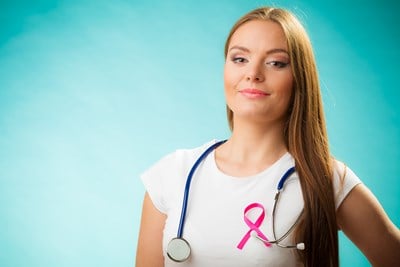What is Breast Cancer?
Breast cancer, like all cancers, is the uncontrollable multiplication or growth of cells within the body. Breast cancer, specifically, is the abnormal growth of cells located in breast tissue. This growth usually forms a large grouping known as a tumor that separates from cells growing at a more normal rate. This cancerous cell growth can then invade surrounding tissue or spread to other parts of the body, known as metastasizing. Cancer cells that metastasize can cause serious and fatal health complications when left untreated. While the vast majority of breast cancer diagnoses occur in women, man can also develop breast cancer. Breast cancer is the second most common cancer diagnosis after skin cancer for women in the United States.
A woman's breast is made up of glands that can make breast milk, small tubes that carry milk from those glands to the nipple, fatty and connective tissue, blood vessels, and lymph vessels. Most breast cancers begin in the cells that line the tubes which carry milk from milk glands to the nipple. The lymph system consists of nodes connected by vessels that help in the creation on immune system cells. This system stretches across the body. Due to the presence of lymph vessels in the breast tissue, breast cancer that is not treated can easily spread to other parts of the body.
Breast cancer cells can travel in lymphatic vessels and begin to grow in lymph nodes. If cancer cells spread to lymph nodes, there is a greater chance that the cells have also spread to other places in the body. The more lymph nodes that have cancer in them, the more likely it is that the cancer will be found in other organs or will reappear later after treatment.
Causes
Doctors don't know exactly what causes breast cancer. Some risk factors are known to increase the chances of diagnosis. These include aging and having changes to certain genes. Others include using certain types of hormone therapy after menopause, being overweight, and not getting enough physical activity. Many women who are diagnosed with breast cancer, however, don't have any known risk factors other than being female and older.
Symptoms
Breast cancer can cause a change in the way the breast feels. The most common symptom is a painless lump or thickening in the breast or underarm. The skin on the breast may dimple, or the entire breast may change in size or shape. The nipple may turn inward, and the skin around it may look scaly. A fluid discharge from the nipple may also indicate the beginnings of breast cancer.
During a regular physical exam, the doctor may check your breasts to look for lumps or changes. Depending on your age and risk factors, the doctor may advise you to have a mammogram, which is an X-ray of the breast. A mammogram can find a lump that is too small to be felt. If you or your doctor finds a lump or another change, the doctor will want to take a sample of the cells in your breast, called a biopsy. The results of the biopsy help your doctor to determine the type of cancer.
Treatments
Together, you and your doctor will decide which treatment is right for you based upon the type of cancer, as well as family history or other health problems. Breast cancer is usually treated with surgery, radiation therapy, or chemotherapy. In some cases, you may need to decide whether to have surgery to remove just the cancer or surgery that removes the entire breast.



